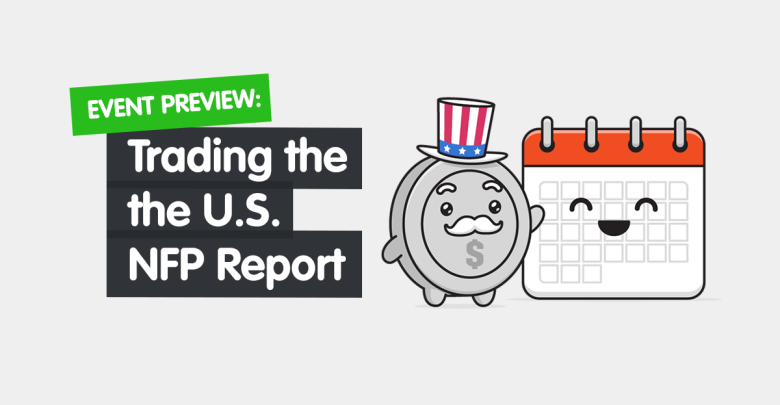
Is Uncle Sam gearing up to print another strong jobs report?
Or are we about to see a downbeat June NFP?
Here’s what you need to know if you plan on trading this top-tier event:
Event in Focus:
U.S. Monthly Employment Situation Summary from the U.S. government for June 2023
When Will it Be Released:
July 7, Friday: 12:30 pm GMT
Use our Forex Market Hours tool to convert GMT to your local time zone.
Expectations:
- U.S. Non-Farm Payrolls Change m/m: 224K forecast vs. 339K previous
- U.S. Average Hourly Earnings m/m: +0.3% m/m forecast vs. 0.3% m/m previous
- U.S. Unemployment Rate: 3.6% forecast vs. 3.7% previous
Hiring activity is expected to have been slightly slower at 224K in June compared to the previous month’s 339K increase in employment. This might still be enough to bring the unemployment rate down a notch from 3.7% to 3.6%.
Meanwhile, wage growth is expected to stay consistent with another 0.3% uptick in average hourly earnings. Now this data point might be a key driver for dollar direction since rising wages tend to translate to stronger consumer inflation.
Relevant U.S. Data Since the Last U.S. Non-Farm Payrolls Report:
? Arguments for Strong Jobs Update / Bullish USD
- CB consumer confidence index for June improved from 102.5 to 109.7, as the assessment of current business and labor conditions climbed from 148.9 to 155.3
- Weekly initial jobless claims were trending gradually higher in the first three weeks of June, before chalking up its biggest week-over-week improvement since October 2021 in the week ending June 24
? Arguments for Weak Jobs Update / Bearish USD
- ISM manufacturing PMI for June came in below expectations, with the employment component falling from 51.4 to 48.4 and signaling a contraction
- S&P Global manufacturing PMI for June reflected industry contraction at 46.3, as hiring “was modest overall and softer than in May.”
Note: ADP non-farm employment change figure, Challenger job cuts and JOLTS job openings and ISM services PMI to be released on July 6
Previous Releases and Risk Environment Influence on USD
June 2, 2023
Action / results:
The May NFP report churned out yet another batch of stronger than expected results, as the U.S. economy added 339K jobs versus the estimated 180K gain.
Although the unemployment rate came in at 3.7% versus the projected uptick from 3.4% to 3.5%, components of the report revealed that this was mostly due to higher labor force participation.
Average hourly earnings came in slightly below expectations with a 0.3% uptick versus the projected 0.4% increase.
Overall, this led to a big boost for the Greenback across the board on Friday, as dollar traders revived hopes for a June Fed hike instead of a “Fed pause.”
The rally was mostly enough to pare losses from earlier in the week when debt ceiling concerns were in focus and a couple of Fed officials talked about “skipping” a rate hike in June.
Risk environment and intermarket behaviors:
This trading week was off to a slow start, as European and U.S. banks were on holiday mode on Monday. A bit of optimism weighed on the safe-haven dollar then, following weekend headlines that U.S. lawmakers reached a tentative deal on the debt ceiling.
Expectations of a potential Fed pause in June and stronger than expected Chinese Caixin manufacturing PMI also lifted risk appetite around the middle of the week, dragging the lower-yielding dollar further south.
May 5, 2023
Action / results:
The April NFP report came in stronger than expected at 253K, surpassing the 190K consensus and leading to an improvement in the jobless rate from 3.5% to 3.4%.
Wage growth was also above expectations, as the average hourly earnings figure showed a 0.5% increase versus the 0.3% consensus.
However, the previous month’s reading suffered a significant downgrade from the initially reported 236K figure to just 165K, suggesting that the labor situation isn’t as rosy as it looks.
The dollar was on weak footing earlier on, but it managed to pop higher when the upbeat headline figures were printed. Then again, the rally quickly fizzled out on profit-taking before the week came to a close.
Risk environment and intermarket behaviors:
Thin liquidity and market jitters from banking sector troubles paved the way for a rangebound start during this trading week.
Volatility kicked in once the RBA, Federal Reserve, and ECB took the stage with their rate decisions. These central banks displayed a shift to a more cautious policy stance, leading to a pickup in risk appetite midweek.
It didn’t help that a couple of U.S. leading jobs indicators turned out weaker than expected, fueling expectations for a weak NFP and also translating to losses for safe-havens.
Price action probabilities
Risk sentiment probabilities:
The FOMC meeting minutes are up for release midweek, just before another slew of leading jobs indicators are scheduled to be printed. These are likely to set the tone for dollar price action ahead of the official NFP release on Friday.
We’ve heard a lot from Fed officials in recent weeks, including continued hawkish commentary from Fed Chair Powell last week at the ECB Forum on Central Banking, so unless we get a surprisingly cautious tone from the Fed meeting minutes, it’s impact on USD and risk sentiment may be limited.
For now, barring any major news surprises with U.S. jobs leading indicators, the broad risk-on lean with some anti-Dollar moves may be the vibe going into the Friday jobs print.
USD scenarios
Base Case:
Based on the previous releases, dollar traders are likely to have a strong reaction to the headline figures before taking underlying components and prevailing market sentiment into account.
Another NFP beat would mark the FIFTEENTH consecutive monthly upside surprise, which might reassure market players that the U.S. jobs market is showing no signs of slowing down.
In this scenario, the dollar might be able to benefit from the prospect of higher U.S. borrowing costs, as well as risk aversion stemming from the impact of tighter policy on global economic activity.
This might seal the Fed’s place among the more hawkish major central banks, which could both fundamental and technical buyers into USD longs, especially against other currencies with dovish or cautious policy stances (NZD, JPY).
Alternative Scenario:
If the actual figures come in below estimates, this would cap off the long streak of upside NFP surprises and probably lead traders to acknowledge a peak in hiring or warning signs of a downturn in the jobs market.
A significantly weak result in drawing investors/traders from all walks of like to price in another pause this July, paving the way for a risk rally and anti-dollar environment.
In this case, watch out for potential short USD plays against currencies whose central banks seem very keen on tightening in the near-term (GBP and EUR).









